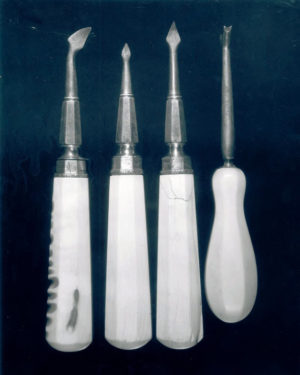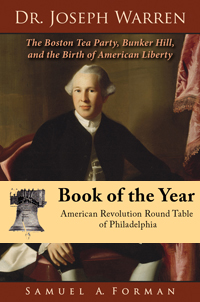Author: Paul Revere (alleged)
Date: 1948
“From Revere’s account books: “Feb 22, 1773, Doct. Joseph Warren. To mend of a Tank and planns. 1.40 To taking out bicuspid 0.40″”
Sources: Weinberger, Bernhard Wolf. Introduction to the History of Dentistry in America. St. Louis: C.V. Mosby Company, 1948. pp. 116-117. The source manuscript which Bernard Weinberger cited, in which no such entry exists as he quoted pertaining to Joseph Warren, is: Paul Revere Waste Book 1761-1783, Vol. 1 of the Revere Family Special Collections, Boston: Massachusetts Historical Society, Ref. Oversize F69 R43 P39 as photostat available to the public, and as Microfilm P-230, reel 5. I am indebted to the MHS staff for retrieving and allowing my direct perusal, as Joseph Warren’s biographer, of the original, fragile, and closely held original manuscript waste book in Paul Revere’s hand. That was about six years ago.
The image is of Paul Revere’s dental instruments courtesy of the National Museum of Health and Medicine, Washington, D.C.
Commentary: This reference purports to prove from an unquestionable primary source that Paul Revere performed dental prosthetic work on Dr. Joseph Warren. Warren’s dental prosthesis was key to identifying Warren’s remains from a hasty battlefield interment over nine months following the Battle of Bunker Hill. Circumstantial contemporary evidence points to this role for Revere, but others could plausibly have performed the services. Silversmith and jack of many trades Paul Revere is first so named well into the 19th century.
A shadow reference is a non-existent passage or entry said to be in a primary source manuscript. If the primary source otherwise exists, and the author citing it purports to adhere to basic standards of scholarship, shadow references are especially insidious. They are fictions which can pass as facts. The ones of which I am aware involve some important aspect of the subject at hand, where an author conjures the shadow reference in support of their position or analysis.
Citation of a shadow reference is proof of shoddy scholarship. This is a ‘one strike and you’re out situation.’ Anyone who besmirches their subject in a scholarly work, by creating or perpetuating a shadow reference, forever calls all of their writings into question. Indeed, if there is anything new or valuable elsewhere in their work, in order to be accepted it must be independently verified from the primary sources by someone with a track record of disciplined scholarship. Otherwise, who is to know what other citations are as-yet unrecognized falsehoods being presented as if grounded in primary sources?
We can only guess at the perverse range of motivations which might explain the invention and perpetuation of shadow references. Deliberate fraud, mental illness manifest as confabulation, desire to be viewed as a scholarly star for findings that others have missed in primary sources (while trusting that no one will expose their deception), and sheer laziness in blindly accepting secondary sources perpetuating someone else’s shadow reference. There are probably other potential motivations I am missing. All are far outside of the pale of acceptable scholarship.
The most notable instance of a shadow reference to date in the biographical context of Joseph Warren can be found in Mary Lokken’s Indians in Our Tree [San Antonio, Texas: William H. Mullen, 1989]. In this genealogical work a number of outlandish if entertaining couplings are alleged within the 18th century Warren family, including ones involving Joseph Warren. These are cited to primary sources that no has been able to verify. As a result Lokken’s work is universally dismissed as unreliable. If it contains anything of value, Lokken discredited herself as a purveyor of shadow references.

 Follow
Follow